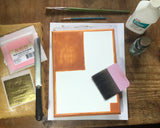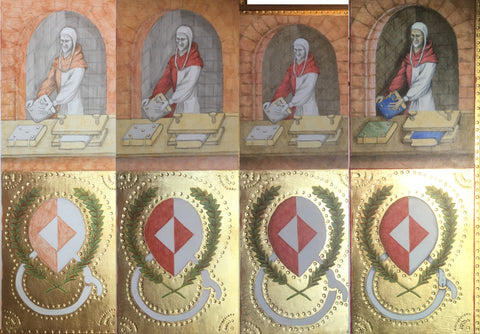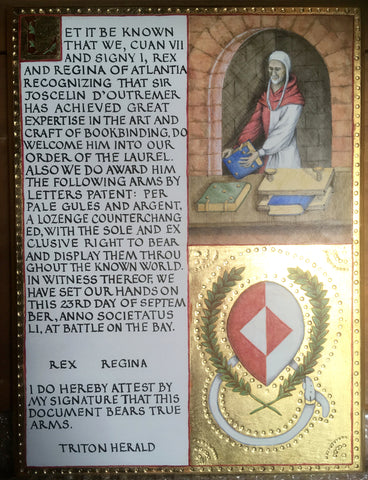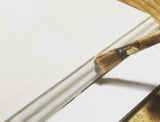Medieval Panel Painting
Posted on October 07 2017
This summer, Nancy had the rare pleasure of creating a special gift for one of her students in the SCA, a medieval history group. Naturally, she did a historically authentic project: A gilded panel painting using historical materials and techniques. Read on to see how she did it!
To begin, Nancy wanted the gift to reflect her student’s interest in medieval bookbinding. She was inspired by wooden book covers from Sienna, Italy, known as the Tavoletta di Biccherna. In the medieval period, the tavoletta were gilded and painted covers used for account ledgers in the office of the biccherna, and they were commissioned from the finest panel painters of the time. (See the links at the end of this article for more information.)
Nancy’s process, step by step
She chose a pine wood panel, roughly 9 by 12 inches, as the substrate, and sealed the entire board with rabbit skin glue, which is available from specialty art supply houses. Next, she coated the front and the decorative edges with several layers of gesso -- not the acrylic type, but genuine gesso made from slaked plaster and glue -- which were sanded down to a very smooth finish.
To apply the 23 K gold leaf, Nancy used the water gilding method, in which red clay, known as bole, was dissolved into glue and painted where the gold leaf would be applied. The clay cushions the gold leaf and provides a warm undertone. After several layers were applied and sanded, the bole was wetted to reactivate the glue and very thin sheets of 23 K gold leaf were applied and then burnished to a brilliant shine. Afterward, she gently stamped the gold to create small circular patterns that catch and reflect the light, creating a dazzling surface.


In keeping with the other authentic materials, Nancy used egg tempera paints handmade from raw egg yolk and dry pigments. Egg tempera is done slowly, in many layers of very small strokes that must dry in between layers. The painting took several weeks to finish. See the photographs of how the layers were built up over time! The painting for the laurel leaves and initial L were done over the gold leaf, and after painting was finished Nancy carefully scraped away some of the paint to reveal the gold underneath (a technique known as sgraffito).


More information
Achivio di Stato Museum: http://www.hotelsienaborgogrondaie.com/hidden-places-in-siena-tavolette-di-biccherna-museum/ and http://www.archiviodistato.siena.it/
Technique: http://temperaworkshop.com/technique/technique1.htm
Nancy's other artwork
Although this project was a gift, originals and prints of Nancy's calligraphy artwork can be purchased in our shop, and Nancy does accept commissioned artwork during the winter months.



